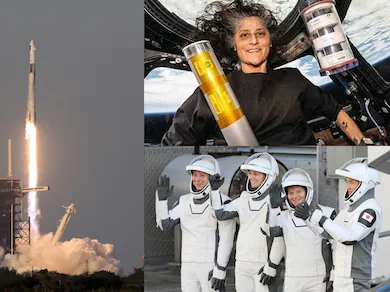NASA’s Crew-10 mission is an exciting chapter in the ongoing legacy of space exploration. As part of this mission, astronauts aboard the International Space Station (ISS) will bid farewell to Sunita Williams, one of NASA’s most accomplished astronauts, as she returns to Earth after a long tenure in space. Crew-10’s primary objective is to safely dock with the ISS, conduct mission operations, and bring Williams back home. This mission has captured the attention of space enthusiasts and the general public alike, as it marks another milestone in human spaceflight, particularly in the realm of long-duration missions and the management of complex space station activities.
Overview of Crew-10 Mission
The Crew-10 mission is part of NASA’s ongoing collaboration with SpaceX, utilizing the Dragon capsule to transport astronauts to and from the ISS. The spacecraft launched from Kennedy Space Center aboard a Falcon 9 rocket. One of the key goals of the Crew-10 mission was to facilitate the safe return of Sunita Williams after her extended stay aboard the ISS. Williams, a veteran astronaut with over 50 days of spacewalking experience, had been on the ISS for several months as part of a mission to maintain and enhance the functionality of the space station.
This mission also represents a significant moment for NASA as it continues to develop the capabilities for human space exploration beyond low-Earth orbit. The Crew-10 spacecraft, launched by SpaceX, is a prime example of the success of public-private partnerships in space missions. Not only does it transport astronauts, but it also delivers cargo and scientific equipment that are crucial for conducting experiments in space, which will contribute to future space exploration missions, including those to the Moon and Mars.
Sunita Williams’ Return to Earth
For Sunita Williams, this mission is particularly special as it marks her return to Earth after an extended mission aboard the ISS. Williams, who has become a symbol of excellence in space exploration, spent a considerable amount of time on the ISS, contributing to various scientific experiments and space station maintenance. Her return signifies the culmination of years of dedication and hard work in space. It also marks the end of her time in space, as she will soon be replaced by other astronauts for the continuation of space station operations. Williams’ contribution to the mission was significant, particularly in the areas of robotic operations, spacewalks, and scientific research.
Crew-10 Docking Process
The Crew-10 spacecraft’s docking with the ISS was a highly anticipated event. The docking process is critical to the safety and success of the mission, as it ensures the safe transfer of crew members and cargo between the spacecraft and the station. The SpaceX Dragon capsule was designed with advanced docking capabilities to allow for autonomous docking, with minimal human intervention required. On the day of the docking, the spacecraft approached the ISS with precision, and the onboard systems were monitored closely by ground control and the astronauts aboard the ISS. After a series of successful maneuvers.
The crew members aboard Crew-10 were in high spirits as they entered the ISS, and their work was immediately focused on ensuring the safety and well-being of their colleagues, including Williams. They helped prepare Williams and the other astronauts for their return journey and conducted several checks on the spacecraft to ensure its readiness for re-entry into Earth’s atmosphere.


SpaceX’s Role in the Mission
SpaceX’s involvement in the Crew-10 mission is another testament to the company’s growing role in space exploration. Since being selected by NASA to transport astronauts to and from the ISS under NASA’s Commercial Crew Program, SpaceX has played a pivotal role in advancing the capabilities of space transportation. The Crew Dragon capsule, which is part of SpaceX’s Dragon family of spacecraft, has been used for several successful missions. Its design features cutting-edge technology, such as touchscreen interfaces, autonomous docking capabilities, and advanced life-support systems, making it one of the safest and most reliable spacecraft in operation today.
The Crew Dragon capsule is a reusable spacecraft, which makes it a more cost-effective solution for space travel compared to traditional expendable rockets. This innovation is part of a broader effort to make space more accessible and sustainable for future missions, including those beyond low-Earth orbit.
Mission’s Impact on Future Space Exploration
The Crew-10 mission is not just about returning astronauts to Earth but also about paving the way for future space exploration. NASA’s goal is to develop the necessary technologies for crewed missions to the Moon and Mars. The data collected from missions like Crew-10 is invaluable for understanding the challenges of long-duration space travel and life on the ISS. Additionally, the successful use of commercial space vehicles like the SpaceX Dragon is a significant step forward in reducing the cost of space missions and making space more accessible.
Furthermore, the Crew-10 mission helps NASA in its preparation for the Artemis program, which aims to return astronauts to the Moon and establish a sustainable human presence there by the late 2020s. The lessons learned from the Crew-10 mission and similar missions will inform future deep-space endeavors and contribute to the success of humanity’s exploration of the Moon, Mars, and beyond.
Conclusion
The Crew-10 mission is a remarkable achievement that highlights the successful collaboration between NASA, SpaceX, and international partners. The safe return of Sunita Williams to Earth marks the end of another successful chapter in her space career, while the mission itself sets the stage for future human exploration missions. As NASA and its partners continue to develop the technology and infrastructure needed for deeper space exploration, Crew-10 stands as a testament to the power of innovation and collaboration in the pursuit of human space exploration.
FOLLOW:https://newsroom47.com/rohit-sharma-to-retire-after-2027-world-cup/
Newsroom 47
